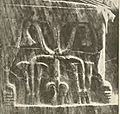Upper and Lower Egypt facts for kids
Upper and Lower Egypt refers to a period in Ancient Egypt when the country was split into two main parts. It was often called the Two Lands. One part was Upper Egypt, located in the south, stretching from the city of Aswan up to Cairo. The other part was Lower Egypt, found in the north, from Cairo all the way to the Mediterranean Sea. South of Aswan, the land turned into the Nubian desert.
Contents
Ancient Egypt's Two Lands
For a long time, ancient Egypt was not one big country. Instead, it was divided into two separate kingdoms. These kingdoms had their own rulers, symbols, and ways of life. Understanding this division helps us learn about how Egypt grew into a powerful empire.
Where Were Upper and Lower Egypt?
Imagine the Nile River flowing through Egypt.
- Upper Egypt was in the southern part of the country. This might sound confusing because "upper" usually means higher up. But it's called "Upper" because it was upstream on the Nile River, closer to the river's source. Its land was mostly narrow, with cliffs and deserts on either side of the river. Its capital city was Nekhen, also known as Hierakonpolis.
- Lower Egypt was in the northern part of the country. This area was downstream on the Nile, closer to where the river flows into the Mediterranean Sea. It was a wide, flat delta region, very fertile and shaped like a triangle. Its capital city was Buto.
Why Were There Two Separate Lands?
These two regions had different cultures and traditions. Upper Egypt was more rugged and mountainous. Lower Egypt was a flat, fertile delta. Each region had its own symbols.
- The symbol for Upper Egypt was the white crown and the lotus flower. Its protector goddess was Nekhbet, a vulture.
- The symbol for Lower Egypt was the red crown and the papyrus plant. Its protector goddess was Wadjet, a cobra.
These differences led to them developing as separate kingdoms for many years.
How Egypt Became One Country
Around 3100 BCE, a powerful ruler from Upper Egypt, often thought to be King Menes (or Narmer), conquered Lower Egypt. This brought the two lands together under one ruler for the first time. This event was super important. It marked the beginning of the Early Dynastic Period in Egypt. From then on, Egypt was mostly a united country. The pharaohs, who were the kings of Egypt, wore a special double crown. This crown combined the white crown of Upper Egypt and the red crown of Lower Egypt. It showed that they ruled over both lands.
Symbols of Egyptian Unity
The ancient Egyptians loved using symbols to show their beliefs. The unification of Upper and Lower Egypt was often shown in art.
- One famous symbol is the sema tawy. This means "uniting the Two Lands." It shows the papyrus plant (for Lower Egypt) and the lotus flower (for Upper Egypt) tied together around a hieroglyph that means "union."
- Sometimes, the god Hapi, who represented the Nile River, was shown tying these plants together. This showed that the Nile was the lifeblood that connected both parts of Egypt.
- Pharaohs' thrones and temple walls often featured these symbols. They reminded everyone that Egypt was one strong nation.
Images for kids
-
Hapi tying the papyrus and reed plants in the sema tawy symbol for the unification of Upper and Lower Egypt
-
The river god Hapi uniting Upper and Lower Egypt. Colossi of Memnon. Reign of Amenhotep III.
-
Temple scene at Luxor, Thebes
-
Alabaster Jar depicting the sema tawy symbol with Hapy. From the tomb of Tutankhamun.
-
Ramesses III at the temple of Khonsu.
-
Sema tawy (without deities) on the side of the throne of Khafre
See also
 In Spanish: Alto y Bajo Egipto para niños
In Spanish: Alto y Bajo Egipto para niños







